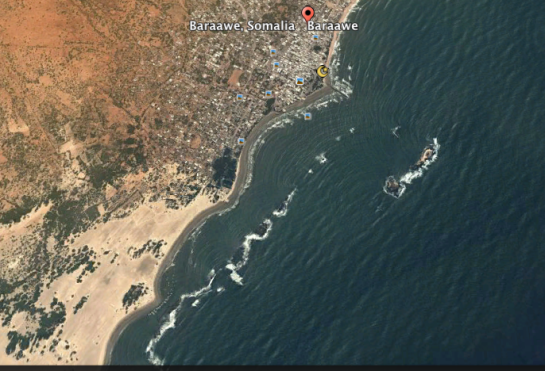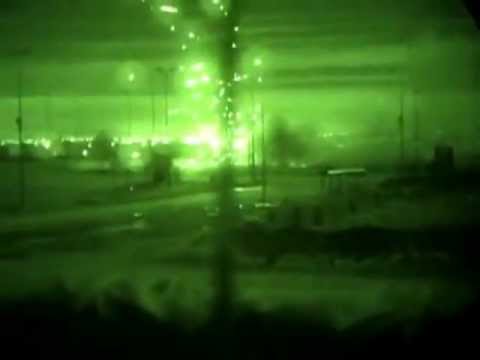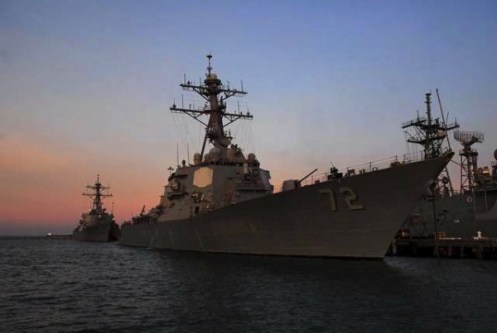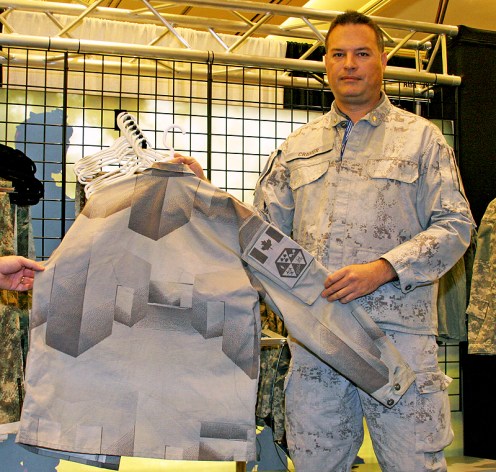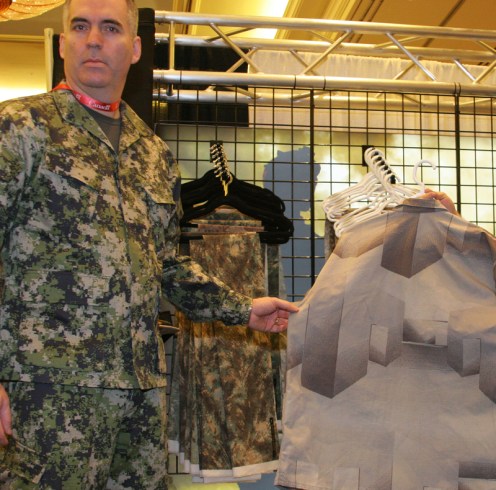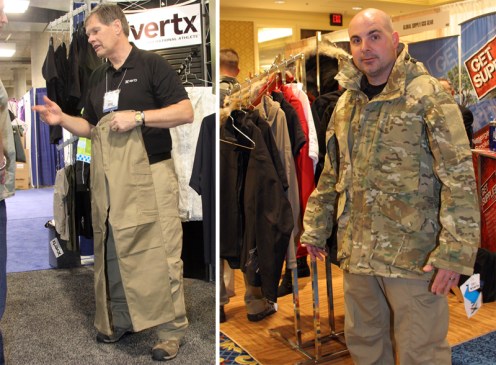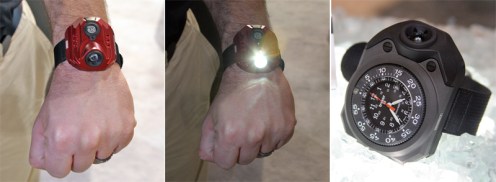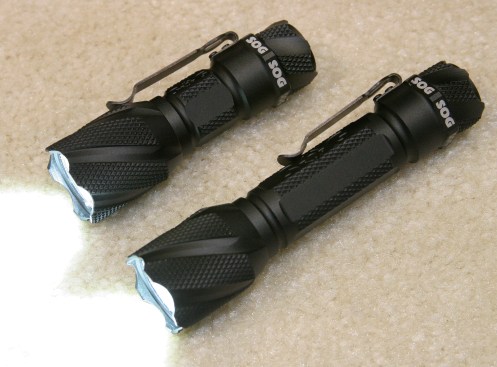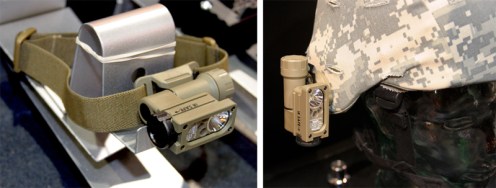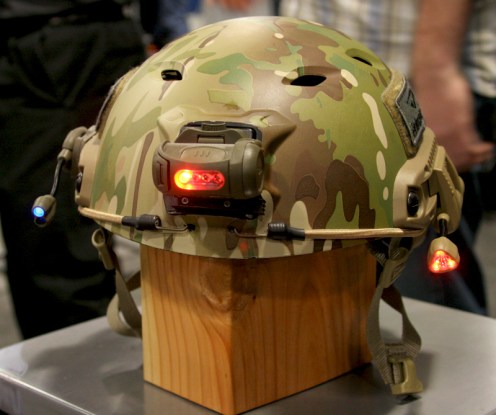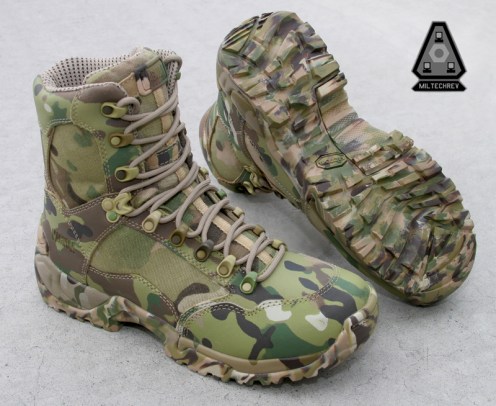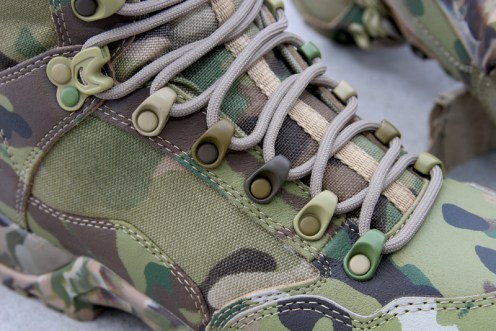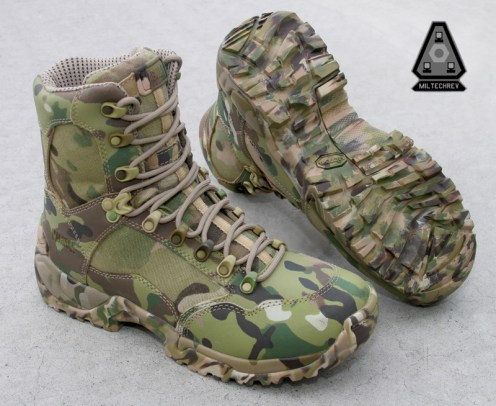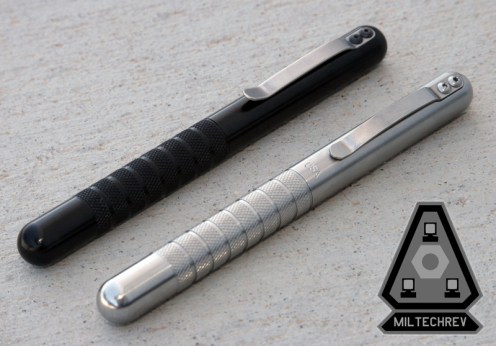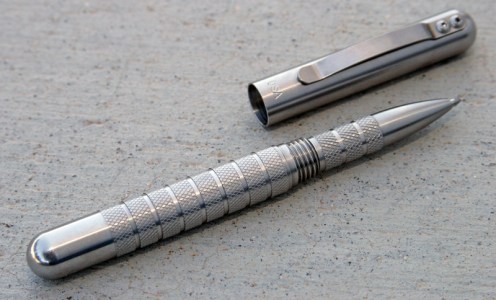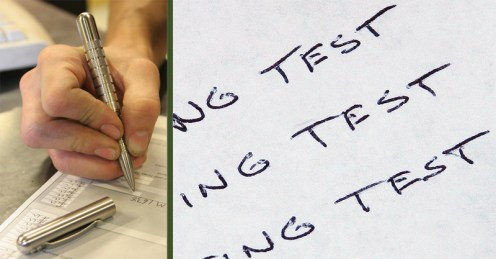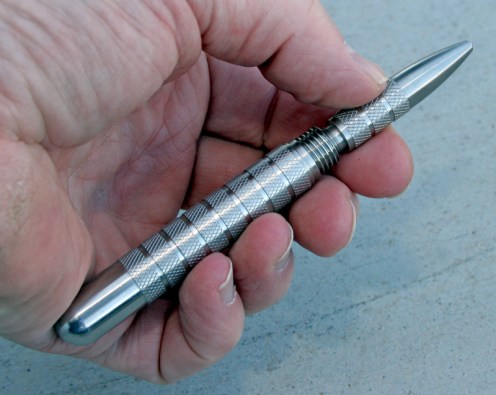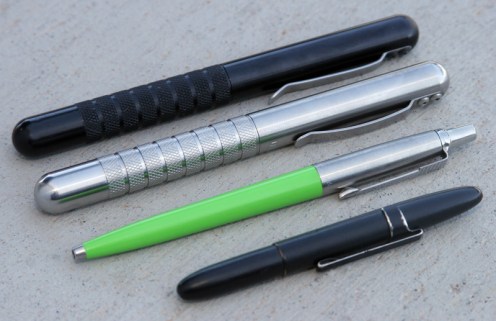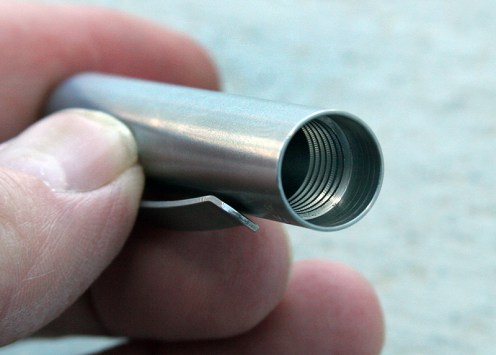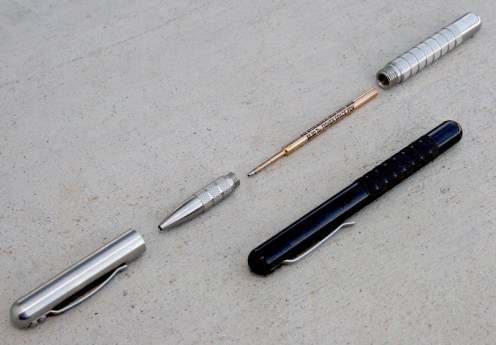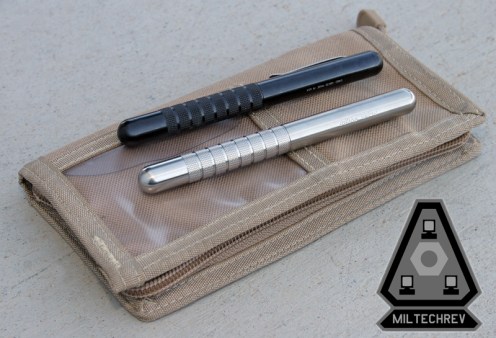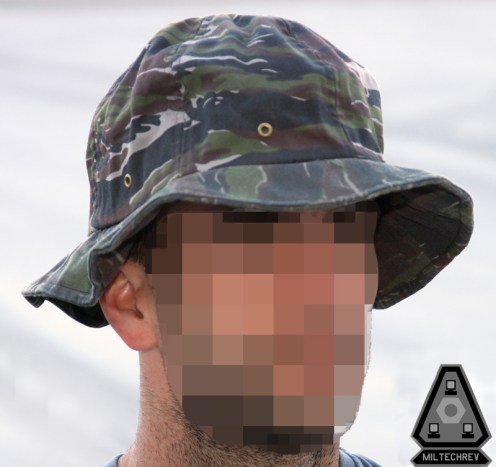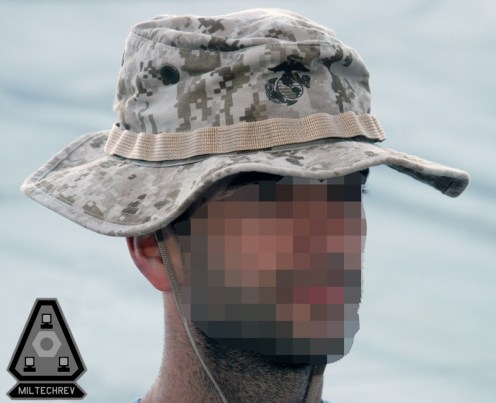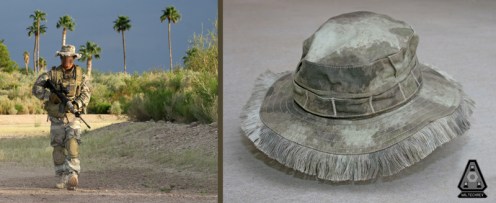By Tom Demerly for MILTECHREV.com
There are three likely options for a U.S. punitive strike on Syria in response to the Assad regime’s use of chemical weapons:
Option 1 is the predictable Tomahawk cruise missile strike. It would likely be launched from the specially equipped USS Stout (DDG-55), the USS Mahan (DDG-72), the USS Ramage (DDG-61), the USS Gravely (DDG-107) and the USS Barry (DDG-933) as they cruise the Mediterranean off the Syrian coast. They would strike the confirmed chemical weapon storage sites with some of their 300+ precision guided UGM-109E Tomahawk Block IV Land Attack Missiles once accurate targeting coordinates (supplied by the Israelis among other assets) are uploaded to the missiles. The destruction will likely be complete and, from a U.S. casualty exposure perspective, antiseptic.
Option 2 is a precision air strike carried out by B-2 Spirit bombers launched (possibly) from Whiteman AFB in the U.S. and supported by French aircraft and assets. This is a complex option for a number of logistical and perceptive reasons. It exposes the expensive B-2’s and their crews to a long flight from Missouri. The mission would require multiple mid-air refuelings along with exposure to risk over the target area.
The B-2 Spirits of the 509th Bomb Wing may be forward deployed closer to the region, at Diego Garcia for instance, as they were to the Philippines during the recent North Korean crisis. That said, B-2’s launched from Whiteman AFB were recently used for precision strikes against Libya. On March 19, 2011, three B-2s of the 509th Bomb Wing struck 45 targets including the airfield at Ghardabiya, Libya. Bomb damage assessment photos showed hardened aircraft shelters at that base were precisely targeted and destroyed by the B-2’s.
The concern with using B-2’s isn’t so much that the Syrians could shoot one down, although their Soviet style integrated air defense network is formidable, it is the complexity of a B-2 raid. A B-2 raid on Syria from Whiteman AFB would likely be over 25 hours in duration. It would cover 12,000+ non-stop flying miles. A benefit of a cruise missile strike compared to B-2’s is, if a Tomahawk missile crashes, no one gets a visit from a chaplain. If a B-2 and its crew are lost that is two terrible messages to deliver and billions in lost technology and training.
Option 3 is the wild card.
A combined French/U.S. special operations team would use intelligence gathered in the previous months by a number of nations, including Israel. The combined task force would infiltrate Syria from the north via land- likely using trucks. They would assault and capture the chemical weapons storage facility with tactical and rotary wing air support, collecting video of the weapons cache- the “smoking gun”for later distribution to news networks . The world would see the verification. The team would perform a match of the stored chemical weapons against those used in the attacks on the Syrian rebels and civilians. There would be minimal exposure to Syrian casualties, good guys and bad, an intact “smoking gun” of captured chemical weapons and a gold star for an administration already renowned for its creativity.
There is no perfect option. Option 1 seems politically antiseptic except for the problem that attacking a chemical weapons cache with cruise missiles risks disbursing the very weapons they are sent to destroy. The US could unwittingly create its own chemical attack. There is also the issue of verification. Tomahawks would make deep, smoking, contaminated craters that could be spun in any number of ways; that there was nothing there, that the strikes spread the weapons even further, that it was, in fact, a pharmaceutical research facility or even that the Tomahawks had carried the gas residue into the target area themselves.
Option 2 is so close to option 1 the line between them is blurred. There is the additional exposure of US aircraft being over Syria. Not that there is much concern over Assad’s forces shooting down a B-2, but more that one may have an in- flight emergency and go down anywhere in the region. Messy. Complex. Same problems as Option 1.
Then there is option 3.
There is a saying that if your favorite tool is a hammer, everything begins to look like a nail. The President has used this hammer before, and hit the nail on the head. The Bin Laden raid was a similar affair. It wasn’t enough to antiseptically dispatch the target with drones or stealth bombers Bill Clinton style. There needed to be a “body”, a “smoking gun”, although hopefully not literally smoking in this instance. Like the Bin Laden raid, there needs to be an airtight case that the chemical weapons seized are the ones used to kill hundreds s of Syrian rebels and civilians. There needs to be irrefutable proof.
The hypothetical play out:
In a three-hour meeting on Friday evening at the White House, Option 3 won. A ninety-minute phone call between the U.S. President and British Prime Minister David Cameron put the requisite parties in touch, and the required wheels turning. Parliament voted the British out, the French were still in.
Planning for Option 3 began at Headquarters; United States Special Operations Command, MacDill Air Force Base near Tampa, Florida. Directives were issued. The units involved were sent into isolation for planning. The U.S. Army and the Navy had maintained a WMD special operations response capability since 9/11. They had deployed operationally several times, mostly in Iraq for WMD recovery. Their commanders brainstormed ideas using existing mission templates for this contingency. It only took an hour to flush out a viable plan by comparing templates to intel. Thirty hours later the assets were in motion. A key part of the plan was to strike while the news cycle still carried the photos of dead Syrian children on their front pages. In the Internet age the public has a short memory for horror.
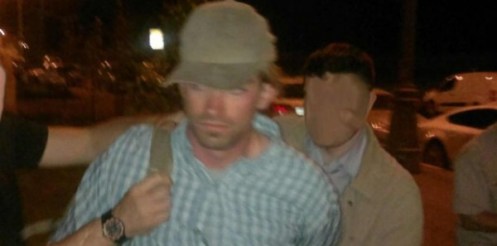
The U.S. special operations team inserted into Turkey under various covers as journalists, aid workers and weapons inspectors before launching their raid into Syria.
The U.S. special operations component of the mission would remain entirely classified, as it usually did except in the case of Operation Neptune Spear, which made for darn good Hollywood and bookstore fodder. No one would ever know the details of U.S. ground involvement in this operation, now internally dubbed “Operation Specific Scalpel”. As far as the media was concerned this was a joint operation between a hastily assembled coalition, the Syrian rebels and with “assistance and support” from the U.S. and France.
Israeli intelligence said the missiles used in the mass attack came from the Adra Industrial City complex to the Northeast of Damascus. In an attempt to maintain maximum unattributability Assad’s special chemical strike units had used an indigenously developed short-range attack missile. The Israelis estimated its maximum range to be no more than 30 kilometers.
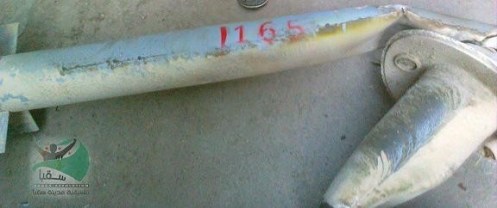
The mysterious missiles that delivered the chemical weapons were nearly impossible to identify suggesting local production adding to their unattributable nature.
The plan was simple. The U.S. and French Counter WMD Special Operations team would covertly infiltrate Syria using trucks from Turkey. They would drive south toward the target in Adra where they would dismount and begin the assault. The objective was not to destroy the chemical weapon storage facility in Adra but to capture it intact and turn it over to a joint Free Syrian security team who would then grant access to chief chemical weapons inspector Ake Sellstrom’s team via UN disarmament chief Angela Kane.
“Special Operations” are called that because there is always a creative element to them. They don’t fit molds or mission templates exactly. This operation had a lot of sharp edges. Any op involving chemical weapons had an ominous aspect to it.
The assault team decided it would not use protective chemical suits. The suits would not facilitate the need to appear as indigenous personnel. The intelligence suggested they were attacking a storage facility, and that the chemical weapons would be “safed” or not assembled in their delivery state yet since it was dangerous even to store them in that state.
The trucks would deploy the assault team around the perimeter of the storage compound. The assault would open with precision shooters neutralizing guards, vehicles and even attempting to breech locks with their .50 caliber sniper rifles.
Under the cover of the sniper/spotters, four assault teams would approach the facility, one from each side. To prevent a “Mexican firing squad” of deadly crossfire only one assault element would push through the target, from the high ground to the north, breeching the fence line with bolt cutters and breeching charges and then fanning out into the rows of storage buildings while the surrounding snipers provided what overwatch they could. Once the facility was seized the supporting international units would insert via helicopter. Included in their charges would be weapons investigators to verify the presence of the weapons and “fingerprint” the chemicals. They would also take possession of the unique delivery rockets from the U.S. commandos who seized the target.
As news of the seizure by the United Nations forces hit the BBC, CNN, Al Jazeera and MSNBC the U.S. team would already be extracting back to Lebanon and back to the ships they deployed from.
By Tom Demerly for MILTECHREV.com

The F-35 was unveiled to the media like a new car model or an up and coming pop star. And subjected to similar public vitriol.
You’ve seen posts on Facebook about the new F-35 Lightening II Joint Strike Fighter contending it’s a “failure”, “a waste”, “damaging to the environment” and even that “F-35 Basing is a Racial Injustice: New Americans and people of color are disproportionately harmed.” The public vitriol surrounding the F-35 program eclipses any previous defense program.
The discussion begs the question, is the F-35:
A. A costly boondoggle spun as a super plane by the Pentagon “old boy network”?
B. The next ultra-weapons system that will render nation-users invincible?
C. A combat aircraft at the beginning of a typically difficult development program?
The reality is “C”.
Another reality is the F-35 is the first major weapons system to do combat on the battlefield of social media. Social media is a great equalizer among combatants. All you need is a laptop and “friends” to fight a battle with the biggest defense contractors on earth. Whether you are Lockheed or Larry Smith the anti-F-35 activist, every opinion on social media is 800 x 600.

The F-35 in its low-rate initial production phase at Lockheed-Martin’s Fort Worth, Texas assembly facility.
If you add some historical context to the development of military aircraft you see daunting realities. Firstly, the F-35 is actually doing quite well for such an ambitious project. In fact, some of the criticism for what has been described as “delays” may actually be the F-35 program’s primary drawback: too much caution. Partially because the magnifying glass of public opinion has focused so much heat on the F-35 the program has ground slowly ahead with more than the typical degree of caution.
Let’s look at some previous military aircraft development programs and think about how they would fare under “trial by Facebook”.

An early model B-17 Flying Fortress breaks up over Germany in WWII. More airmen died in the first versions of the celebrated bomber than any combat aircraft in WWII.
In WWII my father was a draftsmen for Boeing Aircraft in Seattle, Washington at “Plant 2” near the Duwamish River. His first project was drawing a quickly conceived update to the B-17 Flying Fortress: a chin turret with two forward facing .50 caliber guns. The first eight versions of the B-17 lacked adequate guns to defend themselves from a frontal attack. German pilots quickly learned to attack the B-17 from high and head-on, or “Twelve O’clock High”. The results were catastrophic. Early B-17 crews attacking Germany had better odds of dying than surviving before completing their required 25 missions. In fact, more aircrews from the Allied 8th Air Force died over Europe than all of the Marines killed in the Pacific in WWII. Today the B-17 is remembered as a “great aircraft”. How would Facebook pundits have treated the first eight versions of the B-17 with a record like that?

A B-29 Superfortress crashed into a meat packing plant in Seattle during its secret testing phase. The program was so classified that firefighters and first responders were initially prohibited from entering the crash scene.
My dad was transferred to a top secret project working on a super bomber that would fly too high to shoot down and carry a larger bomb load than the B-17. It was the B-29 Superfortress, a project so secret he wasn’t allowed to tell my mom what he was working on. The B-29 delivered the only nuclear weapons used in combat. It is largely credited with ending the war in the Pacific. But the B-29 was a difficult and dangerous aircraft to operate. It used four Wright R-3350 engines that were prone to overheating, and catching fire. With a full bomb load while straining to get to altitude it was common for the B-29 to have engine fires. The B-29 killed a lot of U.S. flight crews. The engine problem, combined with navigation and bombing accuracy problems encountered from an undiscovered high altitude wind phenomenon called the “jet stream” forced Maj. General Curtis LeMay to order B-29’s to attack Japan from low altitude, well within range of Japanese anti-aircraft guns. To carry more bombs LeMay told his bomber crews to remove their defensive guns and leave their gunners behind, a request some crews ignored according to the definitive account of B-29 operations, Mission to Tokyo by author Robert F. Dorr. What would people have said about the B-29 program on Facebook?

The General Dynamics F-111 was originally intended as a multi-role, do everything aircraft for both the Navy and the Air Force. The Navy dropped it in early development, opting for the Grumman F-14 Tomcat. It ended its largely undistinguished career in service with the Australian Air Force.
More recently, and in an oddly similar program to the F-35 Joint Strike Fighter, in 1961 former Defense Secretary Robert MacNamara asked for a feasibility study on the development of one aircraft that could perform low-level, supersonic penetration bombing missions into the former Soviet Union and also serve as a fleet defense interceptor launching from aircraft carriers for the U.S. Navy. The result was the General Dynamics F-111. The F-111 was never adopted by the navy and served with mixed results in the Air Force. Initial F-111 operations in Vietnam were a catastrophe, with 50% of the aircraft being lost and the Vietnam deployment being halted. The one shining moment for the F-111 came during Operation El Dorado Canyon under the Reagan administration, when F-111’s attacked Libyan airfields in retaliation for Libyan sponsored terrorist attacks on U.S. servicemen. A version of the F-111 never initially envisioned, the EF-111 Raven electronic warfare aircraft, did serve successfully in the early Gulf war but, in general, the entire F-111 program fell well short of its original multi-role, multi-service concept.
These are three examples of aircraft that had major problems eclipsing anything the F-35 faces. But that was a long time ago. We’re not in a major air war with a similarly equipped air force. Technology has come a long way. Engineering tools exist today that were unheard of even in the 1970’s when the current generation of operational combat aircraft were first conceived. And those are some of the reasons the F-35 has been treated unfairly.

The development and production costs of the F-35 are to be shared between a host of nation-users, but the Eurozone crisis and global recession has placed more economic pressure on the program.
When cost estimates for the F-35 were originally drafted much of the development program included the new generation of virtual prototyping and testing. Computational Fluid Dynamics replaced early prototype flight-testing. Finite Elemental Analysis replaced actual strain gauge developmental analysis. The business model for the F-35 included development in the virtual space spread over international economies of many user-nations. Each of these factors left opportunities for a host of variables to act on the program and drive costs up. Some of those variables, such as the European economic crisis, have become a reality.
Another reality is the need for all combat aircraft to evolve significantly over their life span. The F-16, FA-18, AH-1 Cobra and AH-64 Apache are just a few legacy aircraft flying today that have undergone such sweeping updates they only vaguely resemble their original versions. The F-16 now has conformal fuel pallets, different control surfaces and improved sensors installed. One version of the FA-18 has gotten larger wings, new intakes, improved avionics and become an entirely new aircraft called the EF-18 Growler. And then there is the B-52 bomber, the plane that just won’t die. The B-52’s in operation now are older than their flight crews. They were based on lessons Boeing learned from- you guessed it- the B-17 and B-29 development programs my dad worked on in WWII. And the B-52 is still flying. People post photos of them on Facebook now, talking about how amazing an aircraft it is. Social media wasn’t around for the bumpy development years.

U.S. Marine Corps test pilot Lt. Col. Russ Clift performed the first F-35B night-time vertical landing aboard the USS Wasp off the Maryland coast last Tuesday, August 13, 2013. The F-35B replaces the aging AV-8B Harrier for the U.S. Marines and the Royal Navy.
The F-35 wasn’t developed in the middle of a world war, but it is being fielded in one of the most volatile periods in history, when enemies use airliners as attack aircraft and superpowers are fielding a new generation of combat aircraft like the Russian T-50 and the Chinese J-20. While it’s unlikely Al Qaeda, Islamic Jihad and their radical splinter organizations will field a new- or any- combat aircraft the ability to command the airspace over insurgent controlled territory has kept their doctrine in the Stone Age. It has also helped prevent another 9/11.
The F-35 won’t bring peace to the world. It isn’t the final answer- no single combat aircraft is. It’s likely not even the best combat aircraft ever. But it is a viable next generation multi-role combat aircraft with a degree of information sharing and mission flexibility that can’t be retrofitted to aging current aircraft systems. It is also designed to fight a war we don’t know everything about yet: the next one. And while uncertainty, at a minimum, swirls around the F-35 on the vaunted spaces of social media the one thing that is certain is, that next war will come.
By Tom Demerly for MILTECHREV.com.
NSW Publications has released a comprehensive new reference book on all aspects of United States Navy Special Operations titled United States Naval Special Warfare by Greg F. Mathieson Sr. and David Gatley. The book is a large wardroom-table size 13.5 X 10 inch (35.5 cm X 25.5 cm) and is 403 pages long, weighing a hulking 8 pounds. It contains hundreds of new, never published, photos in addition to the original text.

Both an entertaining visual experience and a valuable reference, “Naval Special Warfare” contains accurate insights into SEAL and SWCC equipment from the past, current and even into the future.
The Navy SEAL book category is a crowded one with Amazon.com returning 4,389 results for a search on the book topic “Navy SEALs”. What sets United States Naval Special Warfare apart is its freshness, accuracy and scope. Previous large format photo books on Naval Special Warfare have contained generic, public release official U.S. Navy photos usually seen in numerous publications. United States Naval Special Warfare uses photography we’ve never seen in previous books or publications. Even the photos of historical, older SEAL training and operations in United States Naval Special Warfare are original.
Co-Author/Photographer Greg E. Mathieson Sr. served over a decade in the U.S. Army prior to becoming an expert in defense photography. He is the founder of MAI Photo News Agency, a journalistic resource that specializes in military and tactical photojournalism. Mathieson has published photos in every major, mainstream news publication. His relationship with each branch of the military and his experience as a member of the U.S. Army provide him with a degree of technical insight that, arguably, no other photojournalist currently enjoys. Mathieson’s photos bring this book to life as an engaging and fascinating insight that serves as a strong visual reference.
Co-author David Gatley owns three Pulitzer Prize nominations and has 35 years experience as a professional photographer. He is also a former RAND Corporation analyst for military weapons systems. Gatley owns six tours in the Middle East with deployed combat units. He has also done commercial photography for General Dynamics, Lockheed, ITT Defense and has provided imagery of sensitive material to his clients.
A big part of the appeal of United States Naval Special Warfare is the scope of the subject matter. Topics given short-shift in previous books are examined in detail in Mathieson and Gatley’s book. Of special note are new photos and detailed insights into submersible operations and SEAL delivery vehicles past and present.

We’ve never seen this level of detail and insight into the (previously) secret SEAL Delivery Vehicles.
The book also devotes considerable photography and insights into the Special Warfare Combatant-Craft Crewman (SWCC) branch of Naval Special warfare with new insights into their littoral boat technology, operations and the training and history of their crews. While much has been written about the SEAL teams themselves, there is very little available reference material on the Special Warfare Combatant-Craft Crewman units.

Mathieson and Gatley’s photography is fresh and original, even in depictions of Naval Special Warfare team operations from a number of years ago.
Most gallery style military books are primarily photo references but Naval Special Warfare backs up the great, original photography with accurate, detailed and in some cases, previously unavailable insights into Naval Special Warfare. Additionally, the text is well written and engaging. Nailing both the photography and the writing in a book that reports on a secretive society is a high bar to clear, and Naval Special Warfare sets the new standard for books on this subject.

Significant attention is given to the special operations “brown water” navy, the Special Warfare Combatant-Craft Crewmen units in “Naval Special Warfare”.
Finally, if you enjoy well made and archival, library quality paper books the construction of Naval Special Warfare is impressive. The giant book uses a real “case binding” with beautiful quality case cloth on the board outer of the binding with nicely done shoulders on the signatures of the book binding. This is a historical grade binding and printing that can serve as an empirical research resource in libraries.

The cover on our review copy had no paper slip cover, likely because of the elaborate, deeply embossed Naval Special Warfare Insignia.
The cover of the book features a deeply and intricately embossed insignia of the Naval Special Warfare Command and the SEAL qualification badge, the Trident. It looks like something you’d see on a flag pole outside the Phil H. Bucklew Naval Special Warfare Center in Coronado, California.
Every aspect of Naval Special Warfare is covered in detail and with currency and authority in Naval Special Warfare. This book is the start point for any literary survey of Naval Special Operations and will be an important title in any collection of books on Naval Special Warfare.
The book is currently sold directly from NSW Publications LLC for a “Printers Promotional Price” of $65.00 with an advertised “List Price” of $98.00.
By Tom Demerly for MILTECHREV.com

Quiet, shy and unassuming, Caleb Crye is like many great innovators. It was a pleasure to meet him in person, and a little tricky to get him to smile for our cameras.
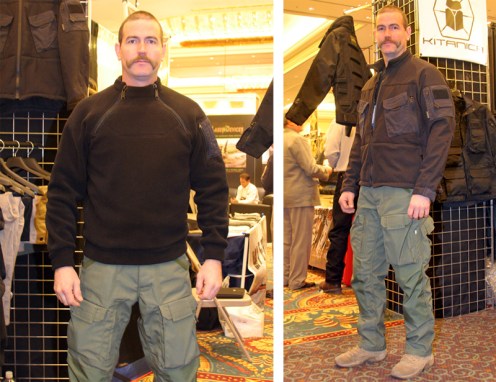
Beej Cronin, Mastermind Designer of Kitanica shows us their new 2-Zip Fleece (left) of heavy Polartec 300 Thermalpro and the impressive Kitanica Winter Softshell jacket in windproof and water repellant Polartec Powersheild.
The second tactical apparel innovator we were so impressed by is Vertx. Vertx discreet tactical operator pants are the very best low profile tactical pants we’ve used. The fit, fabric, pattern, pockets and overall features are superb. It’s the tactical pant you can wear without looking… too tactical.
The gem in Vertx’s booth was their new Vertx Multicam Smock. This new version of the classic parachutist’s smock uses new patterning, fabrics and design details to reinvent the tactical smock category. This completely replaces the conventional field jacket, merging an active insulation layer with a shell garment that spans a wide range of temperatures and climates. The Vertx Multicam Smock packs so much technology and design innovation into one garment we are devoting an article to its review (coming soon).
We have one final update in our SHOT show 2012 Series here on MILTECHREV.com.

Surefire showed their new Wristlight combined watch and flashlight, an innovative direction in tactical lighting.
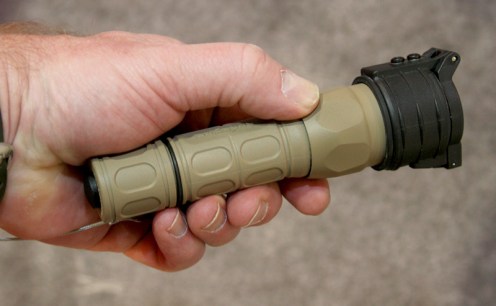
Surefire's new G2X Nitrolon LED tactical light brings high performance lighting to the sub-$100 price point for 2012.
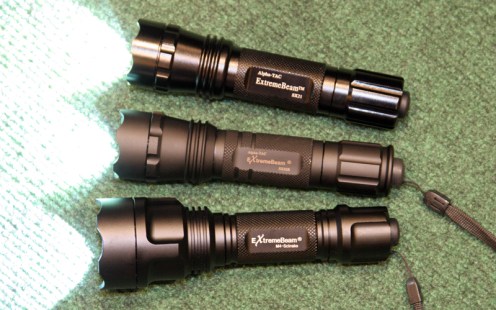
ExtremeBeam showed a wide variety of nice quality, value priced lights with double sealed alloy bodies, shatter resistant lenses and nice feeling switches.
 The evolution in tactical footwear was never more evident than at SHOT 2012. Danner’s impressive booth featured this beautiful U.S. made, Berry compliant boot for 2012 called the Rivot TFX.
The evolution in tactical footwear was never more evident than at SHOT 2012. Danner’s impressive booth featured this beautiful U.S. made, Berry compliant boot for 2012 called the Rivot TFX.
In our first round of SHOT Show 2012 coverage for MILTECHREV.com we look at new footwear innovations and some proven styles shown at the SHOT show in Las Vegas, Nevada from January 17-20th, 2012 at the Sands Convention Center.

Danner's new DFA is an update to the tactical boot harkening back to the original Adidas GSG-9 but in a more durable platform with fast-rope specific features and a stealth sole.

A new low-quarter version of Danner's Melee in Canteen color with a 1000 denier nylon upper makes for a lightweight, comfortable and durable everyday low profile shoe.
One of the most impressive boots in Danner’s 2012 line-up is the Rivot TFX. Rivot TFX is designed for the U.S. Marine Corps as well as other military unit, law enforcement and tactical outdoor use. The Rivot TFX is U.S. made and features a full Gore-Tex sock liner. The upper is 1000 denier nylon with Space Frame Webbing reinforcement built-in that is reminiscent of traditional jungle boot design. The lower portion of the boot is waterpoof rough-out leather that is durable and non-reflective.

The Danner Rivot TFX is intended for the U.S. Marine Corps market along with other military end users.
There is an additional non Gore-Tex version of the Danner Rivot TFX sold in men’s and women’s sizes. Both the Gore-Tex and non Gore-Tex boots are built on the successful Danner Terra Force-X platform in the midsole over a Vibram Rivot TFX outsole with a unique tread pattern that allows “increased pivotal movements”. The boot meets AR 670-1 uniform requirements for “Wear and Appearance of Army Uniforms and Insignia”

Lowa's successful Task Force line has been expanded with more colors including an Air Force uniform color option.

The Magnum Spider 5.1 HPi Multicam boot is a low quarter, lightweight boot with plenty of ventilation and super maneuverable feel. We love this boot for non-garrison wear.
By MILTECHREV Editor Tom Demerly.
Magnum Boots has released their new Sidewinder Combat Desert Multcam HPi boot after initial changes in the delivery schedule. This outstanding boot is worth the wait. The Sidewinder Combat Desert HPi is not an entirely new boot for Magnum Boots. A previous version in solid desert tan has been available and evaluated by over 1456 “testers” in 192 countries according to Magnum Boot’s website.
The primary difference with the latest version of the Sidewinder Combat Desert HPi is the Multicam pattern that covers the entire boot, including the sole. This concept of camouflage boots to provide better concealment for the soldier is relatively new but already proving to be effective and popular. This trend in tactical uniforms marks another functional step away from uniforms that were initially designed for garrison wear such as black or solid color boots.
The Magnum Boots Sidewinder Combat Desert Multicam HPi is packed with technical details that work together to make this an exceptional tactical boot. The features and benefits range from subtle changes in fabric and design philosophy to more conspicuous changes in the outer design of the boot such as the overall camouflage scheme and the unique fast rope panel on the medial instep area.
Three testers wore this boot in size 9.5 US including wear tests while carrying a pack, on technical, rocky desert trails and for long road marches on pavement at speed. We even had the opportunity to do some PT running in this boot.

The packaging and the "Magnum Challenge" 60-Day wear guarantee nomenclature when we received production boots. This is the consumer packaging.
Ion-Mask: Better Boot Performance in the Real World.
A key feature in the Sidewinder Combat Desert Multicam HPi is ion-mask technology. The ion-mask protective layer on the Sidewinder Combat Desert Multicam HPi is an ultra-thin coating layer over a thousand times thinner than a human hair. This coating does not wash or rinse off and is as durable as the material it is applied to. Ion-mask treatment repels water, grit and dust at the fiber level, allowing the fabric to remain breathable and quick drying. It is not a waterproof treatment, but rather, a means of making individual fibers less permiable, more durable and actually improving the breathability and drying speed of the overall fabric made up of the individual ion-mask fibers. Ion-mask even makes stitching on the boot water repellant, making it stronger since it will not soak up water or stretch.
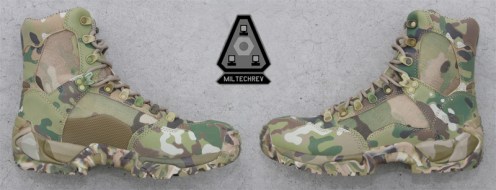
Side views of the boot inside and outside. Notice the fast rope device above the instep on the left.
The ion-mask treatment on the Sidewinder Combat Desert Multicam HPi effectively moderates overall boot comfort, function and performance in the real world. Ion-mask does not fight the losing battle of trying to keep your feet entirely dry in a wet environment. Instead the design of the Sidewinder Combat Desert Multicam HPi works effectively with the environment to protect feet from blisters, moisture and injury. Your feet can get wet in these boots, but they will dry out faster and remain more comfortable than an entirely waterproof boot. If this idea sounds familiar think back to the original jungle boot from the 1960’s. These boots did not fight the losing battle of keeping water out, but rather, took a more pragmatic approach of controlling ventilation and moisture with boot design.
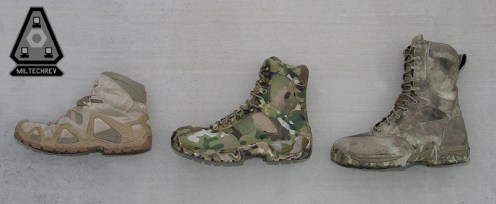
A comparison of relative boot heights for the Lowa Zephyr Desert Boot (left), the Magnum Sidewinder Desert Multicam HPi (center) and the Danner TFX Hot Boot, A-TACS (right).
A drawback to waterproof boots is ventilation and breathability. While most waterproof boots use a waterproof/breathable microporous sock liner to prevent water from getting in they tend to be long on water repellancy but short on breathabiltity. Even the best designed waterproof/breathable boots are noticeably warmer than a similar non-waterproof design. The result is, while your feet may not get wet from external moisture like rain or stepping in water, your skin does get moist from perspiration inside the waterproof sockliner of the boot. As your foot perspires your skin become vulnerable to blisters from being wet. Your footwear system is more reliant on your socks and frequent sock changes, not always possible in the tactical environment. The ion-mask treatment on the Sidewinder Combat Desert Multicam HPi prevents the fibers from soaking up water, allowing them to dry faster, provide better ventilation and prevent soaking.
Another benefit of the ion-mask treatment is the boot stays cleaner since foreign matter does not stick easily and what may stick cleans off much more easily than non- ion-mask boots.
No More Stink: Agion Silver-Based Treatment.
Another proven technology built into the Magnum Boots Sidewinder Combat Desert Multicam HPi is the use of Agion anti-microbial treatment to reduce odor. Agion relies on silver ions to reduce the accumulation of smell from the boots. The boots don’t gather bad smells from perspiration. This silver-molecular impregnation has been used successfully in athletic apparel by endurance sports brands like Pearl Izumi (they make bicycling, running and triathlon apparel). For tactical applications it means you can wear your boots on a week long patrol, pack them in your deployment bag and put them on a C-141, fly home, open the bag and not be gassed by the smell of your own boots.
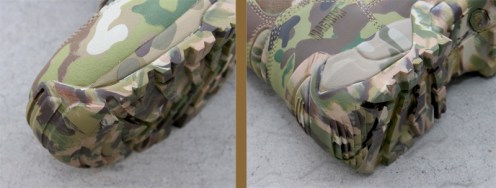
The unique design of the heel and toe of the new Vibram outsole improves traction and handling when climbing and when walking downhill.
SuperFabric: Making Fabric Boots that Wear Longer.
Wear of the boots, especially the fabric sections, is enhanced by using HDM Inc.’s SuperFabric. SuperFabric is a plating technology for increasing fabric abrasion and tear resistance. The earliest versions of fabric boots had the advantages of being cool, lighteweight, quick to break in and functional but they also wore very quickly. SuperFabric armor makes fibers more resistant to abrasion while retaining breathability.
Ortholite Insoles: Aftermarket Athletic Shoe Performance.
Another fabric/material/design feature on the Magnum Sidewinder Combat Desert Multicam HPi is the use of Ortholite insoles right out of the box- the boots come with them. Ortholite is a brand partner with Nike, Merrell, Timberland, Adidas and New Balance. They do insole/orthotic manufacturing for many of these brands and sell their own line of aftermarket orthotics. The advantage to an Ortholite brand insole is materials, engineering, performance and durability. This is a thicker, more anatomically correct and more durable insole than the generic Cambrelle type insole.

The mesh ventilated lining with the Ortholite insole installed (left) and removed (center) and the Ortholite insole removed.
The Boot Design.
Great fabric technologies are no good without good basic footwear design. The Magnum Sidewinder Combat Desert Multicam HPi uses a number of solid design cues to optimize the fabric technologies.
Firstly, the boot is an in-between 8.5″ (21.5 cm) height. I’ll argue this is an optimal height for most purposes. It can be donned easily, provides good ankle stability (along with the outsole- more on that in a moment) and retains reasonably light weight. The boot has a padded and scalloped upper collar. The lacing on this boot is superb. Good boots are a matter of details and this boot has attended to the details. Firstly, the laces: These laces mimmick the feel and weave of .550 parachute cord. The weave of the laces is dense, making them slide through the eyelets more easily and last longer. Before you discount the importance of decent laces consider the awful cotton laces one high end tactical boot supplies their boots with. You have to replace them right out of the box or suffer the consequences in the field. That brand’s boots are great- but the laces are awful. Speaking of lacing, the eyelets on the Sidewinder Combat Desert Multicam HPi also show attention to detail. They are Multicam color keyed and the fourth eyelet from the top is a locking eyelet that helps secure the adjustment of the boot tightness when donning.
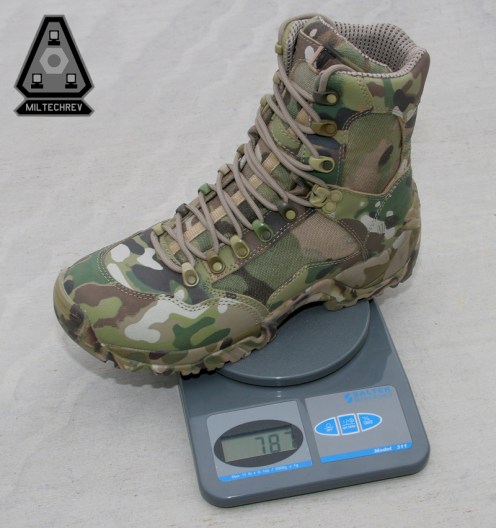
At 787 grams (27.7 ounces) The Sidewinder Combat Desert Multicam HPi is a relatively lightweight boot.
The boot lining is perforated and padded adding to both breathability and out-of-the-box comfort. Tongue design integrates with the rest of the upper to prevent debris from entering and folds easily when donning and lacing. We wore several different weight socks during our wear testing and all worked well, even a very light sock-liner worn by itself.
Toward the bottom of the boot there is a hefty fast rope panel on the medial instep to help dissipate heat and get a grip on the rope. It also helps with rope climbing. The mid sole is described as dual density molded construction. Given the relatively cushioned feel this technical hiking boot/trail running shoe technology seems right at home on this tactical boot.
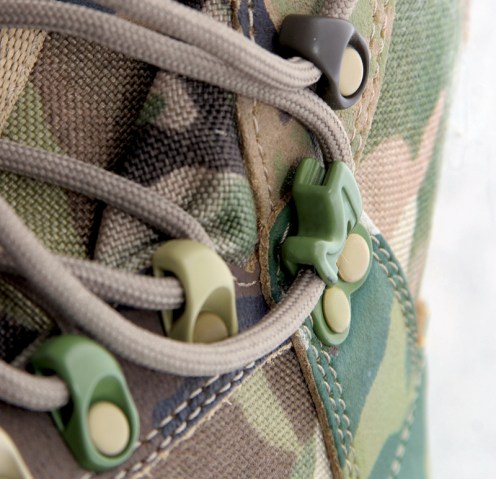
A thoughtful detail on the lacing system is this locking eyelet that allows intermediate adjustment of how tight the boot is.
A particularly nice feature for steep terrain is the radiused-grip heel on the molded Vibram sole. The heel of the boot is partially rounded with a series of grippers molded in. The grippers are angled downward to provide some purchase on the back of the boot if your weight shifts rearward. This is especially important when walking down hill wearing a big ruck. You should already know to keep your weight over the ball of your foot when descending with a ruck on, but this feature is extra insurance if you start to slip or have to descend fast. This technology is borrowed from Vibram’s successful S2V outsoles. These molded, integrated outsoles represent a new direction for Vibram.
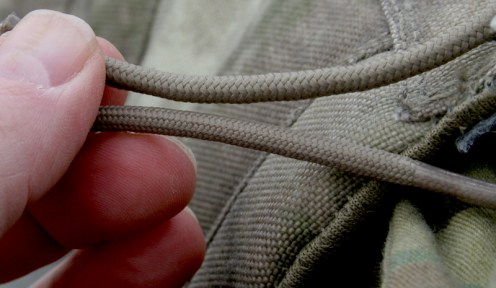
Even little details like more durable, tighter weave laces (bottom) are included on the Magnum Sidewinder Combat Desert Multicam.
The toe portion of the sole wraps upward for better traction. This will also make the boot last longer since a lot of boots die when the toe section of the sole delaminates from upper.
Overall our test boots in size 9.5 US weighed 787 grams or 27.7 ounces (1.73 pounds). Volume in the forefoot and instep/saddle area were spot on for a 9.5 slightly wide foot with average arches. The boots fit well directly from the box. No break in was required.
How Did They Work?
We have been looking forward to this boot for so long that when we finally got them we absolutely beat them. Three testers tag teamed these boots over 2 weeks. They were almost constantly on someone’s feet, almost constantly in motion. When they weren’t marching on pavement they were rucking in the mountains. We hammered them, likely putting 2 months of normal wear for one owner into 2 weeks with three testers sharing one pair.
I put 8.5 hard miles on these boots wearing very thin, low socks directly out of the box. No blisters, no hot spots. The boots felt light and agile and provide good shock absoption. My first impression wearing these is the boots ride “high”. The midsole, insole and outsole are thick. I am taller with these on. There is a lot of “cush” to the soles.
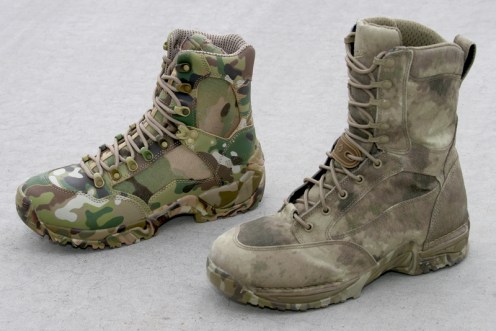
A visual comparison of the Magnum Sidewinder combat Desert Multicam HPi (left) and the Danner TFX Hot Boot, A-TACS (right).
Wear testing them in lose terrain on an 8 mile up, 8 mile down technical trail that climbed to 9,000 feet while wearing 25 pounds at the start (got lighter as the tester ate and drank from their hydration reservoir) was equally impressive: no blisters, great stability, handling and excellent traction, especially descending. No hot spots at the ankle or ball of the foot. Laces stayed tied and adjusted.
We didn’t get the boots soaking wet or swim with them but we did one rope descent on a static trainer- the grippers on the inside are sticky and grip the rope well if you are light and not wearing a pack. We did pull a pair of swim fins over them and they work well with the little Force Fins. I installed a pair of Grivel Air Tech Light semi-rigid adjustable crampons on these boots and, once adjusted, they worked fine. Clearly there is a lot of versatility with the design of these boots.
No review is complete without some criticism and, although any complaint with a boot this nice is about impossible to find we did miss a heel loop to help with donning. Beyond that, we couldn’t find a thing to change.
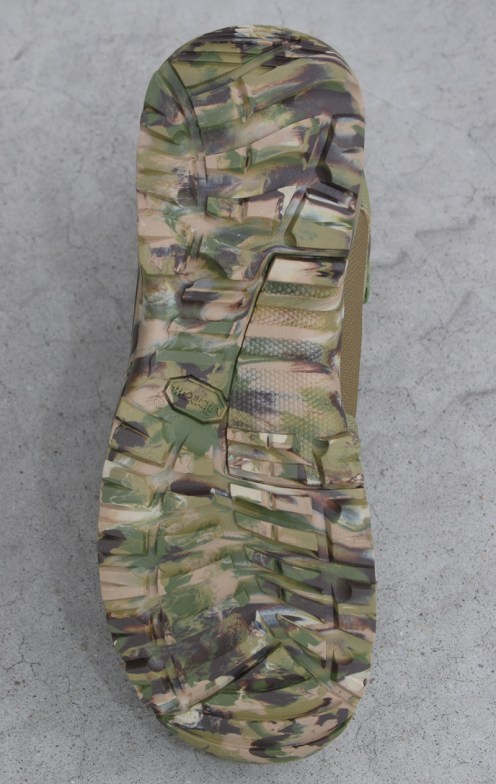
A close look at the Multicam colored outsole. The soles are slightly lighter since soil will cause them to darken slightly with field use.
It took a while for the Magnum Sidewinder Combat Desert Multicam HPi to reach the market but they are absolutely worth the wait. Magnum did well to delay the release of the boot until everything- including reasonable supply- was ready for the consumer market. This boot has been extensively tested around the world in several versions and is absolutely proven now. The new Multicam color scheme adds another layer of function and appeal. The Sidewinder Combat Desert Multicam HPi comes with Magnum’s “Magnum Challenge” 60-Day Guarantee: According to the hang tag in the boot box from Magnum, if you are U.S. customer you can return the boots within 60 days for a full refund if they do not work for you. That suggests Magnum has a high degree of confidence in the performance of this boot.
Our tests also reinforce a high degree of confidence in this boot. They have excellent out-of-the-box comfort and show almost no wear after hard use. Each of us found the boots comfortable, maneuverable and lightweight. None of us developed blisters or hot spots even on varied terrain across wide temperature ranges using different socks and carrying a load. It’s hard to not be impressed by this boot. They were truly worth the wait.

The evolution of the boonie hat started in the early 1960's in popular U.S. military culture and has continued to evolve for five decades.
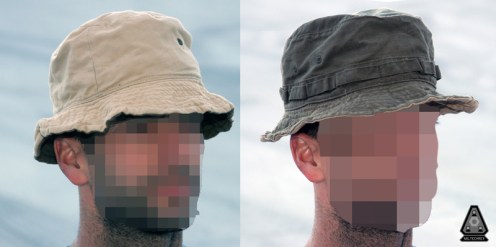
This boonie hat is reversible from desert tan to olive drab with the olive drab side having loops to insert foliage for camouflage. These were never issued but used by intelligence organizations and private contractors and are seen everywhere as casual wear from beach tourists to Abercrombie alterna-teens.
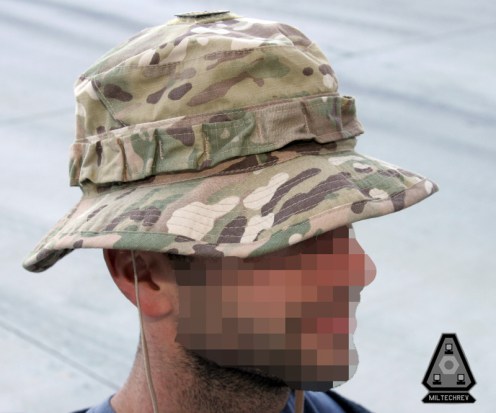
Crye Precision's Multicam boonie hat is packed with features like a drawstring crown, large discreet side vents, Velcro pile IFF patch on top and a nicely sized brim.






